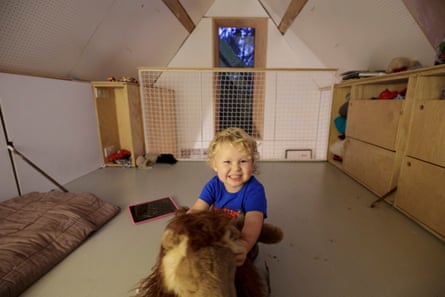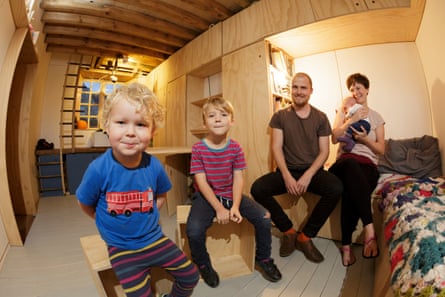As Laura Hubbard-Miles and her husband, Tim Francis, prepared to welcome their third child, their thoughts turned, naturally enough, to their living arrangements. But at a point when most couples start looking for more space, they have instead done the opposite and moved their growing family into a home not much bigger than a garage. The Fruit Store is a 15 sq metre (160 sq ft) stone outhouse that once kept apples fresh but now stores two 34-year-old adults and their children, James, five, Tom, three, and newborn Edith. Even an estate agent would struggle to describe the place as bijou. It is, quite simply, tiny – and that’s partly why they chose it.
While many of us live in poky accommodation owing to a lack of other options, the Laura and Tim have joined a growing number of people purposefully converting to small-scale living – the so-called tiny house movement. Downsizing is hardly a new idea, but its current incarnation is a response to environmental and financial concerns as much as the age-old desire for simplicity and freedom. As house prices continue to rise far beyond the budgets of many families, tiny homes – any residential structure smaller than 46 sq metres – offer a cost-effective and ecologically sound alternative for those prepared to squeeze into them.
The movement has slowly been making waves in the UK after gaining popularity in the US, where the architect Sarah Susanka first championed her Not So Big residential philosophy with the publication of The Not So Big House in 1997. This was followed by Shay Solomon’s Little House on a Small Planet, which offered guidelines for effective and thoughtful small-scale living, and Put Your Life on a Diet, by Gregory Johnson, one of the co-founders of the Small House Society, which now has more than 20,000 members.

Although finding land can be challenging, tiny houses are usually cheap to buy or build. Mark Burton, who runs Tiny House UK, offers custom-built homes from £9,995 and kits from £6,500. They require little energy to heat and power, so are also affordable to run.
Until they made the decision to move to the Fruit Store, the couple lived in a shared-ownership flat in north London, where Tim worked full-time as an architect and Laura as a teacher. “The flat was enormous,” Tim says, slightly wistfully, “but there was no outdoor space and just taking the boys to the park was a real expedition. We knew there was no way we could afford anything bigger and after eight years in London we were getting really frustrated.”
A summer spent in their campervan, volunteering on projects for Worldwide Opportunities on Organic Farms left the couple wondering how the family could live differently. “The last place we stayed was an eco-village in the Alps where our accommodation was this tiny stone building that just had beds and a wood-burning stove,” explains Laura. “It was so cosy and the boys loved it. We’d got used to travelling in a van and living with very little and we thought, could we do something like this? As we were leaving Switzerland, Tim suggested the Fruit Store.”
At that stage, the Fruit Store was being used as overflow storage for Tim’s parents, Mick and Jude, who live in the former gardener’s cottage of the Hatherop Estate in rural Gloucestershire. It was cold and dark with no running water or electricity. But it had the enormous benefit of being cost-free and in a desirable part of the country where the family would otherwise have had no chance of owning a home.
The lack of overheads would offer an opportunity for Tim to take the plunge into self-employment by setting up his own architectural practice – starting with designing and converting the Fruit Store – and would allow him and Laura to spend more time at home with their children. As for the outdoor space they had all been craving – well, outdoors was pretty much the only space they would have. They called Tim’s parents to discuss the idea: “They were unsure at first but quickly became as enthusiastic as we were about giving it a go.” A few months later, the couple had sold their London flat and most of their possessions, won change-of-use planning permission and moved in with Mick and Jude to begin work on the Fruit Store.

In the past 12 months, they have insulated the walls and installed skylights, flooring, electricity and water. Tim’s design packs as much as possible into the limited space. The kitchen consists of a plug-in electric hob unit, a camping fridge and a sink, while the kitchen table unfolds from the wall, with packing crates for chairs. A mezzanine loft doubles as a playroom and bedroom where the two boys sleep on roll-out beds. Built-in benches turn into Laura and Tim’s bed, as well as providing storage for the boys’ toys. Each has one box in which to keep their most treasured items – mainly Lego and colouring pencils. Everything else is squeezed into wall-mounted cubby-holes and drawers upstairs.
Not only does a tiny home consume less energy than a typical family home, it also enables (or forces) those who live in it to consume less, too: there simply isn’t space to keep unnecessary items. Tim admits he initially struggled with this new, minimalist direction. Their sons adapted far more quickly.
“Our time in the campervan was a really important middle ground,” Laura explains. “The boys got used to just having a rucksack each of toys and there was never a point when we were travelling when they seemed to miss their old toys or were stuck for things to play with.”
The move has already meant far more intimacy as a family. “We go to sleep hearing each other’s breathing and we all wake up together,” says Tim. “I asked James what he thought about us living here the other day, and he said: ‘I like it. We’re like a herd,’ which I thought was a nice way of looking at it. As an architect you tend to work on the assumption that a family house is X number of bedrooms, arranged in this particular way to a particular set of measurements, but those are quite sloppy assumptions about what a home is or should be. Trying out living on this scale allows us to test what we really need to live.”
Limited indoor space means more time outside and in the two allotments they have taken on across the road. “We’re far more aware of the seasons than we ever were in London and the fresh air, exercise and intimacy is making Tim and me the most content and fulfilled we’ve been in our adult lives,” says Laura. “We don’t need to earn as much as we used to, so we don’t have to spend as much time working as we used to. We have time together as a family.”
The couple is aware that this initial honeymoon period may not last, especially as the children start school, and that by the time they get closer to their teens such proximity to their parents may be the last thing they want. They are also open to the fact that it may not be something they want to do for ever. They have yet to navigate winter in a tiny house, and the challenges of keeping five people warm and happy when it’s too cold or wet to go outside.
“We’ll be glad we chose to do this. Not everyone would want to put up with living in a space this small, but it’s given us time together which we would never have had if we’d continued living in London and working full-time. It’s definitely an experiment, but we’ll do it for as long as it works.”
Read more about the Fruit Store project at ruralworkshop.net

Comments (…)
Sign in or create your Guardian account to join the discussion